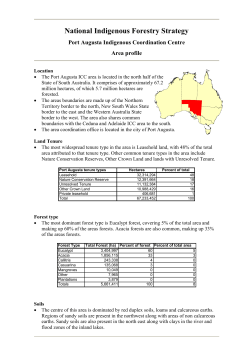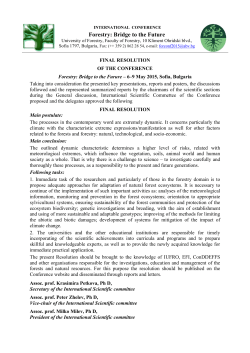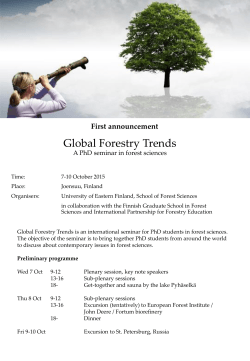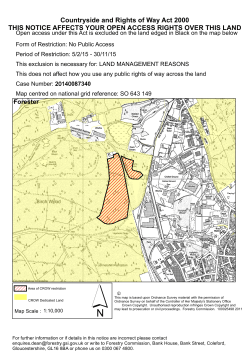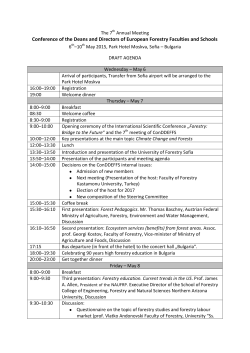
profile - Australian Natural Resources Data Library
National Indigenous Forestry Strategy Kalgoorlie Indigenous Coordination Centre Area profile Location • The Kalgoorlie ICC area is located in the south east of the State of Western Australia. It comprises of approximately 99 million hectares, of which 13 million hectares are forested. • The areas boundaries are made up of the Northern Territory border and South Australian State border to the east and the Great Australian Bight to the south. The area shares common boundaries with the Perth and Geraldton ICC areas to the east and the South Hedland and Kununurra ICC areas to the north. • The area coordination office is located in the city of Kalgoorlie. Land Tenure • The most wide spread tenure type in the Kalgoorlie ICC area is Other Crown Land, with 58% of the total area attributed to that tenure type. Leasehold land is also common, making up 29% of the total area. Kalgoorlie tenure types Other Crown Land Leasehold Nature Conservation Reserve Private leasehold Multiple Use Forest Unresolved Tenure Total Hectares 57,891,904 28,760,917 8,680,583 3,846,889 158,897 79 99,339,269 Percent of total 58 29 9 4 0 0 100 Forest type • The most dominant forest type is Eucalypt forest, covering 10% of the total area and making up 79% of the areas forests. Acacia forests are also common, making up 21% of the areas forests. Forest Type Eucalypt Acacia Casuarina Plantations Total Total Forest (ha) Percent of forest Percent of total area 10,164,148 79 10 2,760,692 21 3 16,004 0 0 10,711 0 0 12,951,555 100 13 Soils • The north of the area is dominated by vast expanses of sandy soils, with patches of loam soils in the northwest. The southern areas of the area are more dominated by loamy soils with areas of non calcareous earths in the vicinity of the city of Kalgoorlie, bordered by calcareous earths to the east and south. A region of yellow duplex soils is located on the far south western coastline. Climate • Climatic zones in the area range from a vast expanse of desert hot (persistently dry) in the north to smaller zones of grassland warm (persistent dry) and temperate distinctly dry (and warm) summer on the southwest coast. • On average the city of Kalgoorlie receives 242mm of rainfall each year, with no major dry or wet periods. • Average daily minimum and maximum temperatures in the city Kalgoorlie Average maximum Average minimum Mid-Winter Mid- Summer 17°C 34°C 6°C 18°C Population • Total population of ICC area: 57,428 (3% of Western Australia’s population and 0.3% of the entire nation’s population). • Largest City: Kalgoorlie-Boulder (28,196) • Largest Indigenous population: Kalgoorlie-Boulder (1,682) Social indicator table Social Indicator Total population (2001) Total population living in urban centres Total rural population Percentage of population living in urban centres Average annual growth rate based on population change (19962001) Number of people employed in forestry and logging Number of people employed in Agriculture, Fisheries and Forestry Persons employed in forestry and logging as a percentage of all persons employed in Agriculture, Fisheries and Forestry Proportion of employed persons working in the industry sector of forestry and logging Number of people employed in Paper and Wood Products Manufacturing Proportion of employed persons working in the industry sector of Wood and Paper product manufacturing Percentage of high income households Proportion of low income households In ICC Area 57,428 46,511 10,917 81% State or Territory National 1,830,155 18,757,139 1,654,705 16,823,254 175,450 1,933,885 90.4% 89.7% -0.6% 52 1.4% 1,459 1.1% 10,944 1,846 36,633 330,466 2.8% 4% 3.3% 0.19% 0.18% 0.13% 27 4,429 63,383 0.10% 35.8% 11.8% 0.54% 28.3% 13.9% 0.78% 29.4% 13.9% ICC Areas: Regional socio-demographic figures were compiled from aggregated 2001 SLA data. The population of an SLA was attributed to an ICC area if over 50% of the SLA fell within that area. Climate information data source: Australian Bureau of Meteorology, (BOM) 2006, ‘Climate Averages for Australian Sites’. Social Indicator data source: Australian Bureau of Statistics (ABS) 1996-2001, Census of Population and Housing. Data based on the place of enumeration. Data supplied by ABS as customised tables at statistical local area (SLA) geography. Disclaimer: Data used are assumed to be correct as received from the data suppliers. The Bureau of Rural Sciences, its employees and advisors disclaim any liability, including all liability for negligence, any loss, damage or injury incurred by any person as a result of accessing, using or relying upon any of the information or data set out in this publication to the maximum extent permitted by law.
© Copyright 2025
